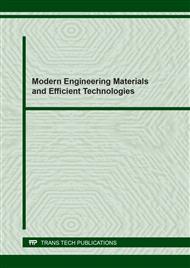[1]
Chapin, D.M., C.S. Fuller, and G.L. Pearson, A New Silicon p‐n Junction Photocell for Converting Solar Radiation into Electrical Power. Journal of Applied Physics, 1954. 25(5): pp.676-677.
DOI: 10.1063/1.1721711
Google Scholar
[2]
Shockley, W. and H.J. Queisser, Detailed Balance Limit of Efficiency of p‐n Junction Solar Cells. Journal of Applied Physics, 1961. 32(3): pp.510-519.
DOI: 10.1063/1.1736034
Google Scholar
[3]
Araújo, G.L. and A. Martí, Absolute limiting efficiencies for photovoltaic energy conversion. Solar Energy Materials and Solar Cells, 1994. 33(2): pp.213-240.
DOI: 10.1016/0927-0248(94)90209-7
Google Scholar
[4]
Luque, A. and A. Martí, Increasing the Efficiency of Ideal Solar Cells by Photon Induced Transitions at Intermediate Levels. Physical Review Letters, 1997. 78(26): pp.5014-5017.
DOI: 10.1103/physrevlett.78.5014
Google Scholar
[5]
Luque, A. and A. Martí, A metallic intermediate band high efficiency solar cell. Progress in Photovoltaics: Research and Applications, 2001. 9(2): pp.73-86.
DOI: 10.1002/pip.354
Google Scholar
[6]
Martí, A., D.F. Marrón, and A. Luque, Evaluation of the efficiency potential of intermediate band solar cells based on thin-film chalcopyrite materials. Journal of Applied Physics, 2008. 103(7): p.073706.
DOI: 10.1063/1.2901213
Google Scholar
[7]
Huang, D., J.-W. Jiang, et al., Group-IV (Si, Ge, and Sn)-doped AgAlTe2 for intermediate band solar cell from first-principles study. Semiconductor Science and Technology, 2017. 32(6): p.065007.
DOI: 10.1088/1361-6641/aa67d7
Google Scholar
[8]
Huang, D., J.-W. Jiang, et al., General rules of the sub-band gaps in group-IV (Si, Ge, and Sn)-doped I-III-VI2-type chalcopyrite compounds for intermediate band solar cell: A first-principles study. Materials Science and Engineering: B, 2018. 236-237: pp.147-152.
DOI: 10.1016/j.mseb.2018.11.006
Google Scholar
[9]
Huang, D., Y. Xue, et al., Ideal half-filled intermediate band position in CuGaS2 generated by Sb-related defect complex: a first-principles study. Applied Physics Express, 2019. 12(2): p.021002.
DOI: 10.7567/1882-0786/aafa0d
Google Scholar
[10]
Chen, P., H. Chen, et al., Fe-substituted indium thiospinels: New intermediate band semiconductors with better absorption of solar energy. Journal of Applied Physics, 2013. 113(21): p.213509.
DOI: 10.1063/1.4808352
Google Scholar
[11]
Gaur, A., K. Khan, et al., Role of intermediate band and carrier mobility in Sn/Fe doped CuAlS2 thin film for solar cell: An ab-initio study. Solar Energy, 2021. 215: pp.144-150.
DOI: 10.1016/j.solener.2020.12.041
Google Scholar
[12]
Chen, P., M. Qin, et al., Cr incorporation in CuGaS2 chalcopyrite: A new intermediate-band photovoltaic material with wide-spectrum solar absorption. physica status solidi (a), 2013. 210(6): pp.1098-1102.
DOI: 10.1002/pssa.201228721
Google Scholar
[13]
Guillén, C. and J. Herrero, Influence of Cu content on the physical characteristics of CuxGaCr0.1S2 thin films for intermediate band solar cells. Journal of Materials Science: Materials in Electronics, 2020. 31(24): pp.22398-22407.
DOI: 10.1007/s10854-020-04741-5
Google Scholar
[14]
Lee, B. and L.-W. Wang, Electronic structure of ZnTe:O and its usability for intermediate band solar cell. Applied Physics Letters, 2010. 96(7): p.071903.
DOI: 10.1063/1.3298553
Google Scholar
[15]
Nezamzadeh-Ejhieh, A. and M. Karimi-Shamsabadi, Decolorization of a binary azo dyes mixture using CuO incorporated nanozeolite-X as a heterogeneous catalyst and solar irradiation. Chemical Engineering Journal, 2013. 228: pp.631-641.
DOI: 10.1016/j.cej.2013.05.035
Google Scholar
[16]
Huang, C., M. Mao, et al., Pressure-Assisted Method for the Preparations of High-Quality AaGaS2 and AgGaGeS4 Crystals for Mid-Infrared Laser Applications. Inorganic Chemistry, 2018. 57(23): pp.14866-14871.
DOI: 10.1021/acs.inorgchem.8b02626.s001
Google Scholar
[17]
Wu, H., X. Li, et al., The synergistic role of double vacancies within AgGaS2 nanocrystals in carrier separation and transfer for efficient photocatalytic hydrogen evolution. Catalysis Science & Technology, 2019. 9(20): pp.5838-5844.
DOI: 10.1039/c9cy01488h
Google Scholar
[18]
Monkhorst, H.J. and J.D. Pack, Special points for Brillouin-zone integrations. Physical Review B, 1976. 13(12): pp.5188-5192.
DOI: 10.1103/physrevb.13.5188
Google Scholar
[19]
Laksari, S., A. Chahed, et al., First-principles calculations of the structural, electronic and optical properties of CuGaS2 and AgGaS2. Computational Materials Science, 2006. 38(1): pp.223-230.
DOI: 10.1016/j.commatsci.2005.12.043
Google Scholar
[20]
Hai-Jun, H., Z. Shi-Fu, et al., First-principles calculations of the elastic, electronic and optical properties of AgGaS2. Physica Scripta, 2010. 82(5): p.055601.
DOI: 10.1088/0031-8949/82/05/055601
Google Scholar
[21]
Suzuki, K., T. Kambara, et al., Low Symmetry Crystal Field Splitting of 4Ti1 States of Co2+ in CuGaS2. Journal of the Physical Society of Japan, 1975. 39(5): pp.1310-1315.
Google Scholar



